64: The descendants of the French regional patterns: 2
A continuation oF the development of the off-spring of the Paris patterns and a few examples of how the French regional figures have inspired modern designers.
There are several more North European versions of the Paris 1 pattern. We saw the Runge design and its descendants in Hamburg and the Scandinavian variants. The Berlin pattern is the only survivor of this export drive in Germany today. But a number were developed in Belgium, some of which went elsewhere, too. In the eighteenth century the design, even when double-ended, was fairly faithful of the original.
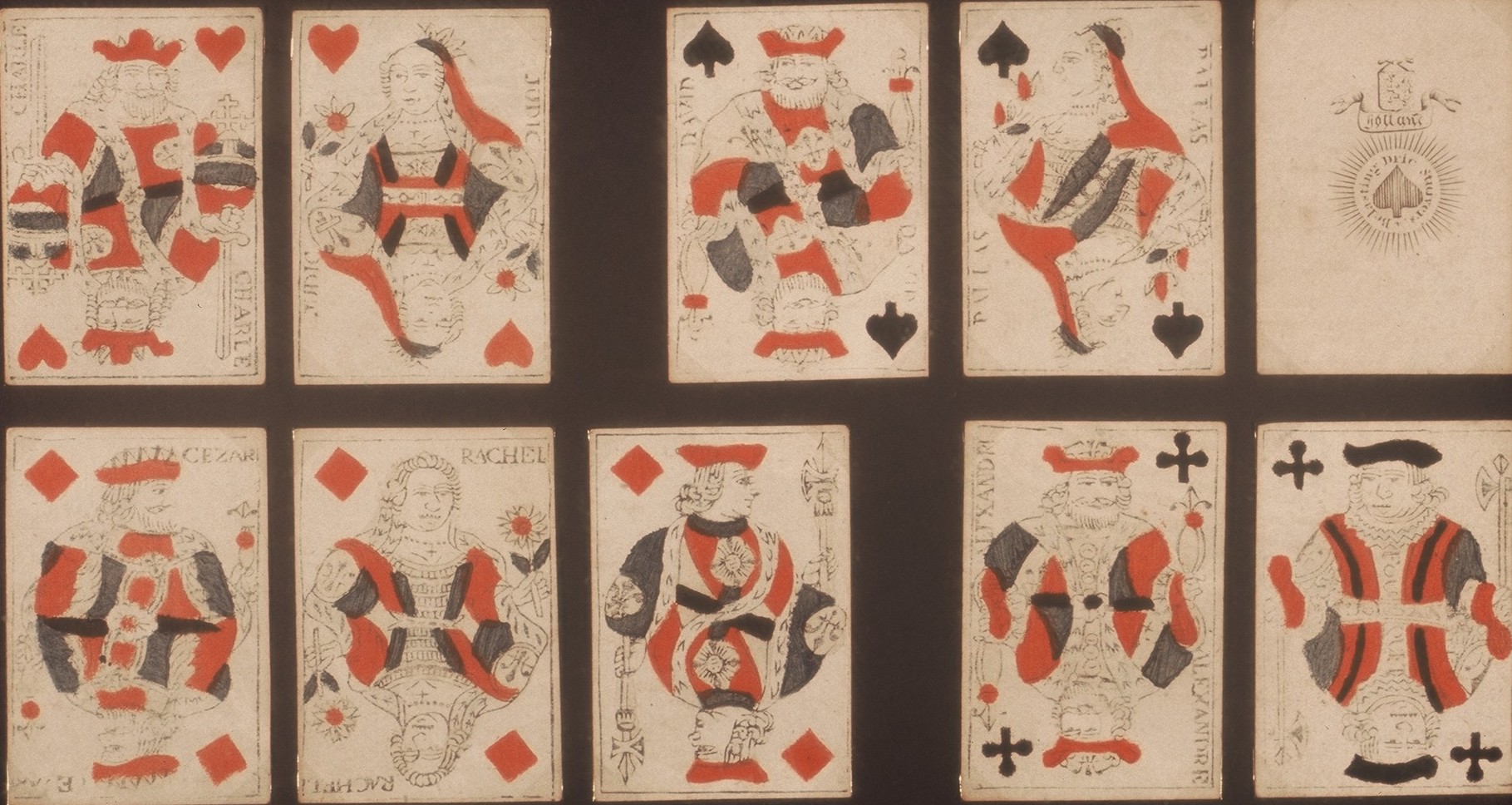 Anonymous late 18th century copy from Holland, c.1780
Anonymous late 18th century copy from Holland, c.1780
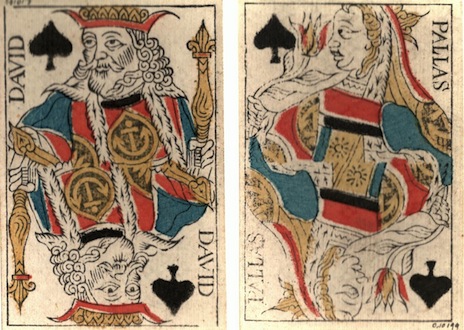
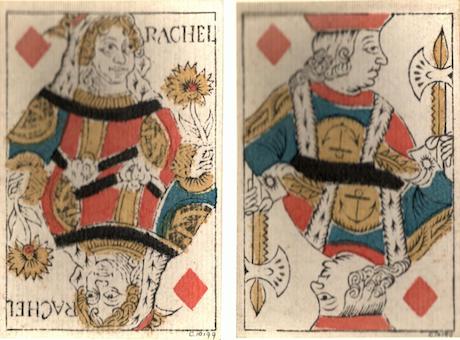
Anonymous 18th century version, probably from North Germany
During the nineteenth century, though, the style changed and became less crudely drawn. There are several illustrated in Turnhoutse Speelkaarten, the catalogue of an exhibition held in 1983 written by van Autenboer & Cremers. By the 1850s the more natural figures had been established as the norm for Paris-related designs. Some of these were quite close to the original, others diverged in different ways. An early example by Servaes has a version in which the design on the JC's sleeve has been reinterpreted as a shield and this feature is perpetuated for quite a while.


Anonymous North German version with the shield, c.1835
Russia had yet another version, more akin to the North German version illustrated on page 63 with three front-facing jacks, but a left-facing KD.
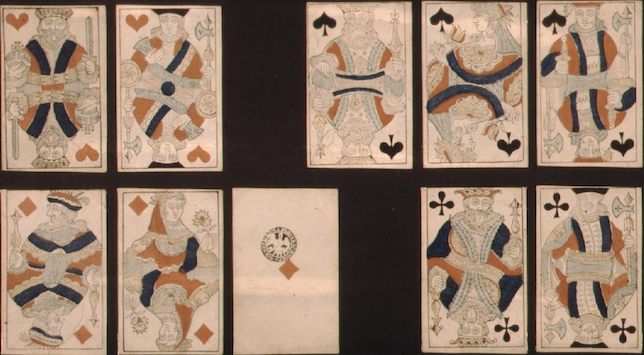
Russian version, c.1830
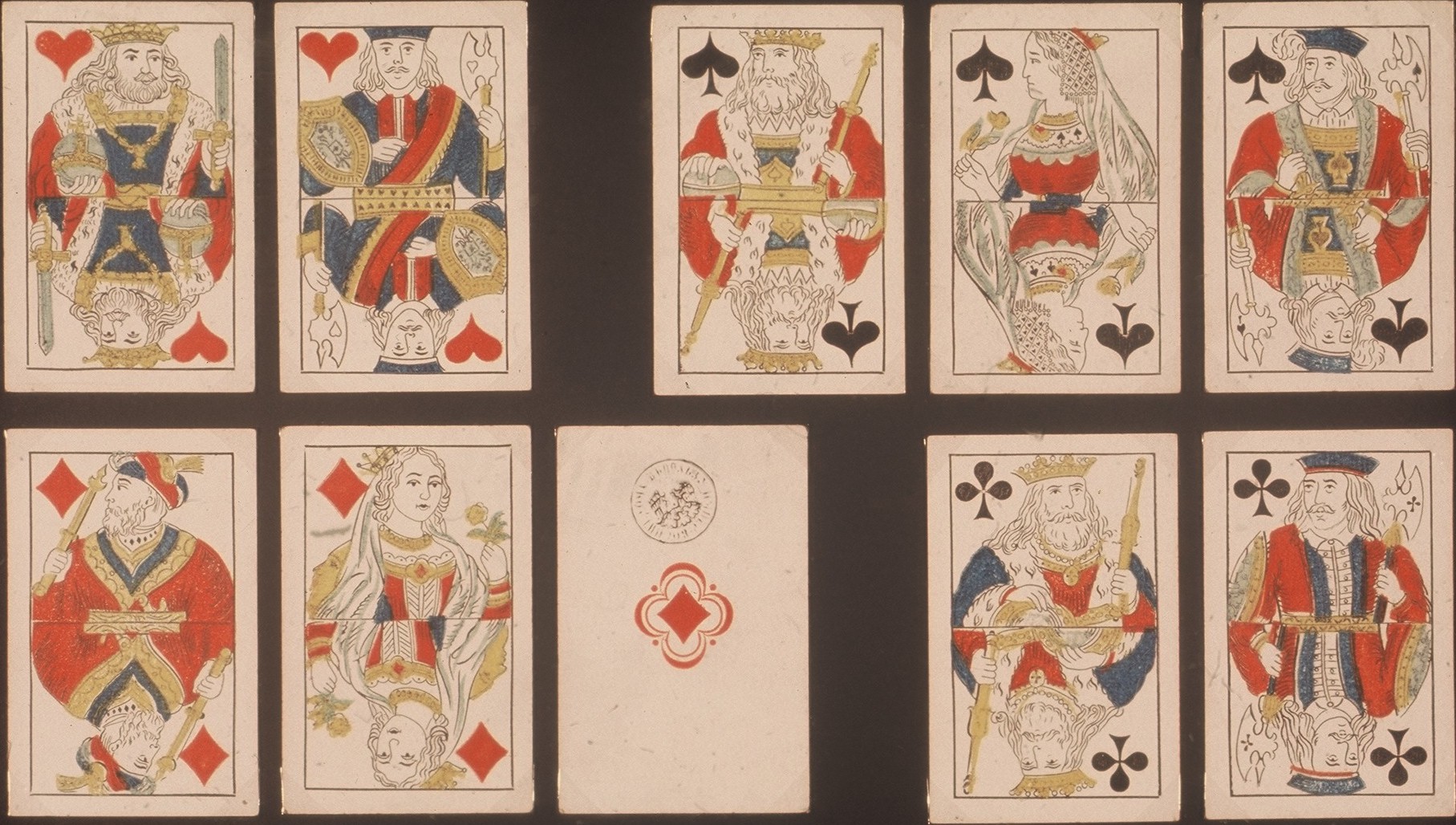 Russian, c.1885; the black jacks' heads have been turned slightly to the left.
Russian, c.1885; the black jacks' heads have been turned slightly to the left.
During the second half of the nineteenth century more and more designs derived from the Paris 1 pattern were produced by the Turnhout makers. Many of these are illustrated in Turnhoutse Speelkaarten; all of them were given names, such as Cartes Royales, Bongoût, Cartes Italiennes, Cartes Turques, Sultan Kaarten. They mostly had pictorial aces, sometimes reflecting the name of the pack, e.g. Cartes Parisiennes had pictures of Paris on the aces. These names were not always applied to the same designs by each maker and some of them were really non-standard designs in the style of the standard ones, but with few or no standard characteristics, e.g. no profile courts, the courts of each suit facing the same way. Since the illustrations in the catalogue are all in black and white, which don't scan well, I'll simply give a couple of examples.
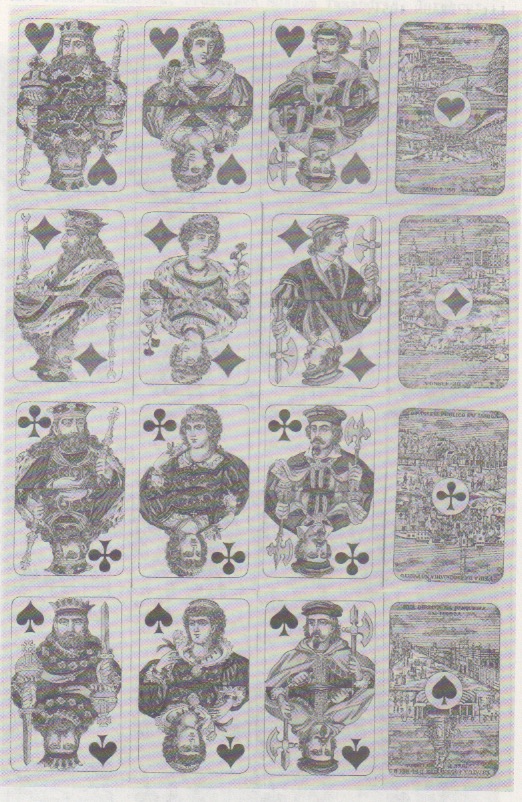
Brepols & Dierckx Zoon Bongoût No.3, also called Nieuwe Allemandes with Portuguese aces, c.1900
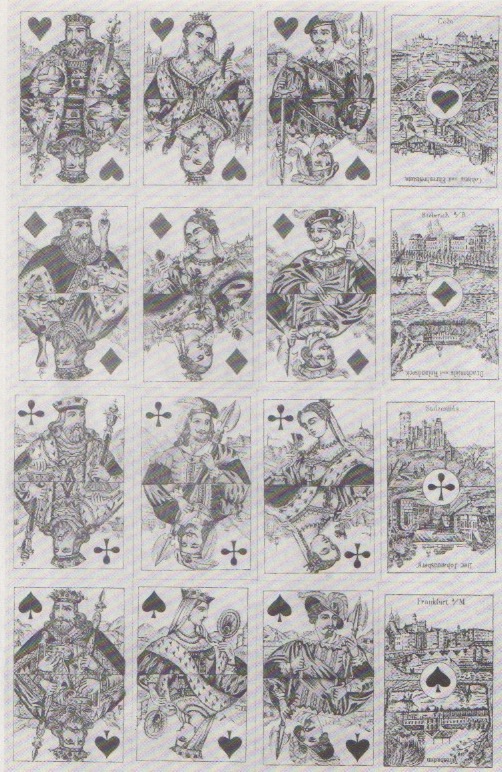
Van Genechten Cartes Royales, c.1895 In this example the courts have background scenes, but this is the design that is now designated the Dutch standard pattern (without the background scenes). Note that there are several original characteristics, but the KD is no longer in profile and the QS faces right not left. The queens, in particular, have become decorative non-entities in relation to the earlier standard design and are the least standard of the courts. For instance, in this pattern the QH faces right and holds a bird on her left hand and the QS holds a fan rather than a flower.
Another Cartes Royales court set, possibly by Brepols, was offered recently on eBay in which the courts are even less standard and have been altered and mixed up in some cases, e.g. the KC holds a harp and looks more like the KD in the preceding pack.
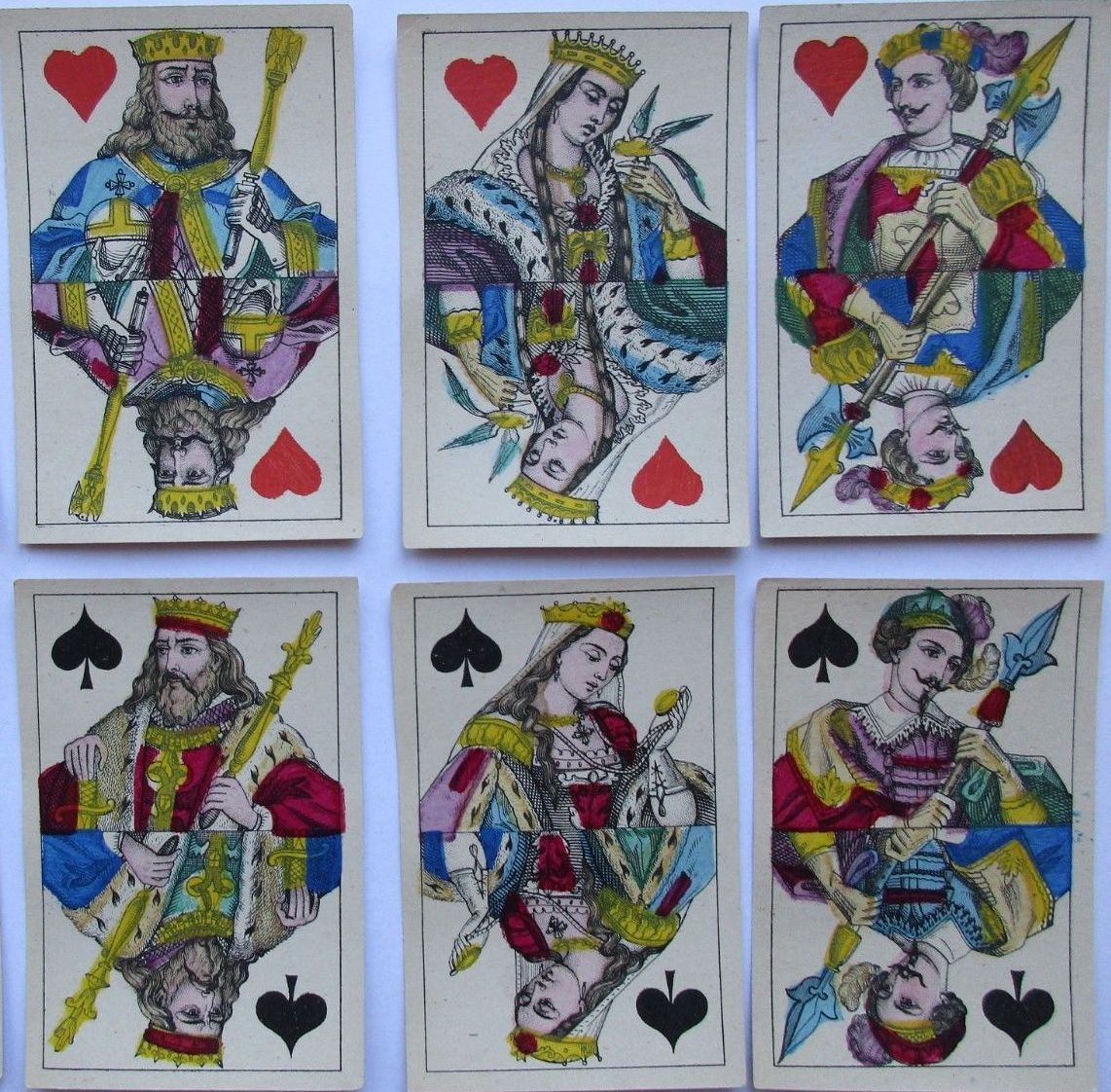

A late version of Paris 1 was still in production in the first half of the twentieth century: Biermans was producing the so-called Cartes marbrées (so-called because of the marbled backs) in the 1920s.
Biermans, c.1920
In Switzerland the Paris pattern was used in the French-speaking areas and made locally.
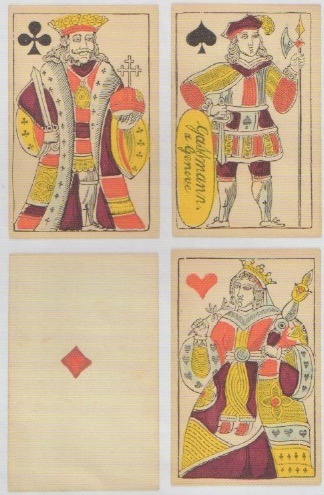
A Swiss version by Gassmann of Geneva, c.1860
By the twentieth century a watered down version of the original pattern was the usual choice for piquet packs. Again the queens have become particularly nondescript, though the QS is still in profile.
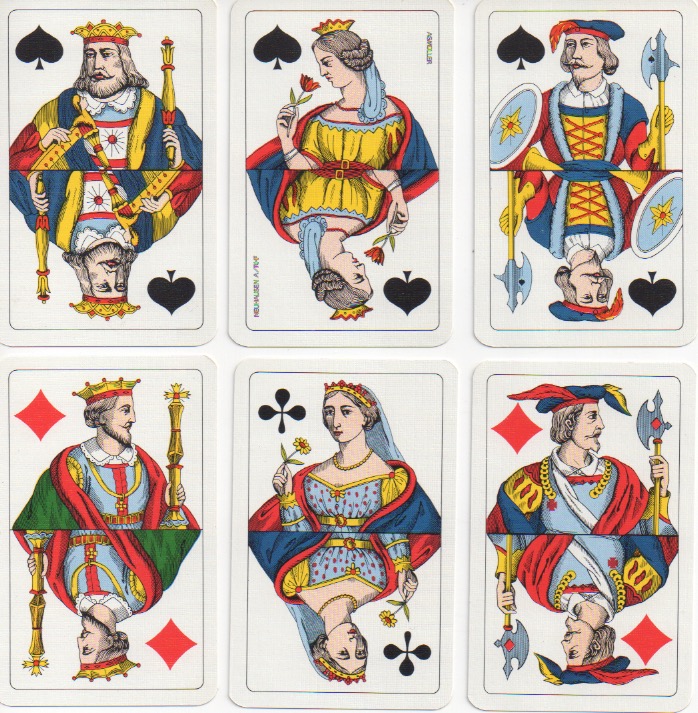
Present-day version by Müller
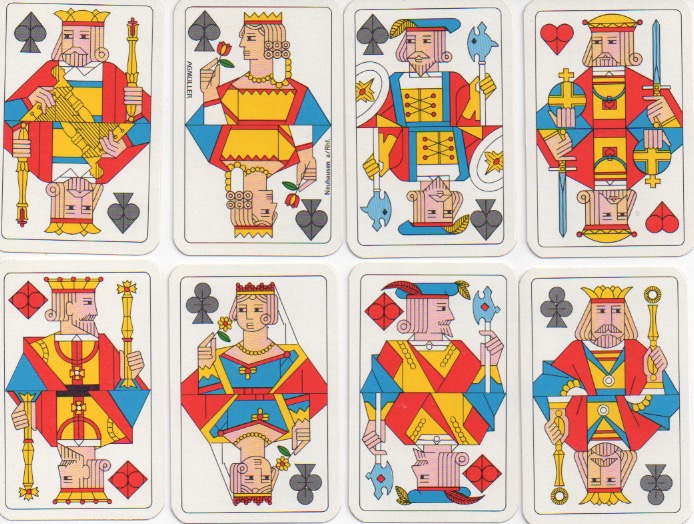
A modernized version in a patience-sized pack
In some non-French versions made locally mixing of the courts' suits has occurred in some cases. In a pack made in Madrid in 1811 shows considerable mixing: the KS is Paris 1 KH, the JH is Paris JD, the JD is Paris JS and the KH is rather nondescript. He could be the Paris KC without his shield or the Lyons 2 KH with a sceptre rather than a scroll. The QC is the Paris 1 QH and the QH could be a turned version of the same figure or the Paris 2 QH with a flower instead of a fan. The QS and JC are the original figures.
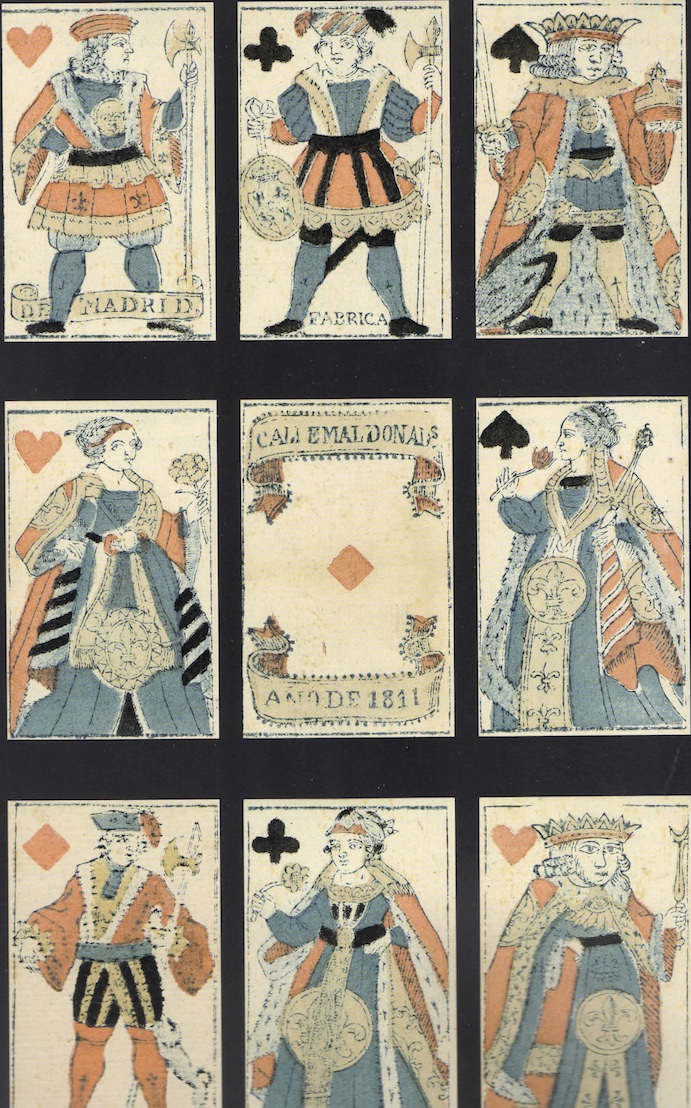
Madrid, 1811
Similarly, there is a pack by Real Fabrica, Lisbon, from c.1800 with a mixture of Paris 1 and Paris 2 and an odd KS, who is actually the Paris 2 KD. The KC has been altered and has his right hand on a sword, the JH has no tunic and the QC is from Paris 1.
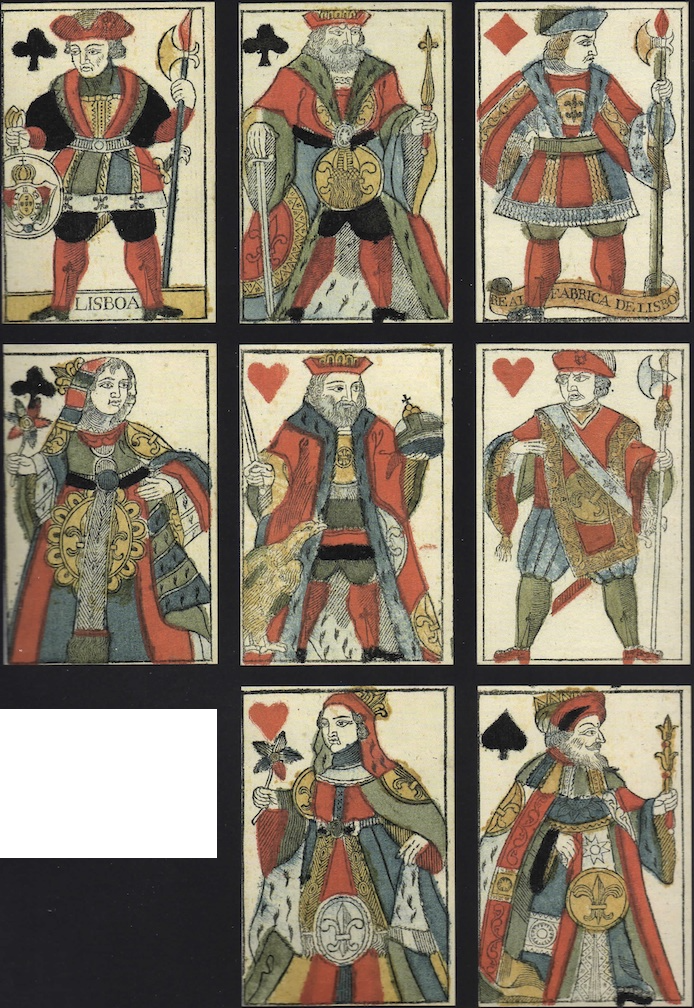
Real Fabrica, c.1800
The standard Milan pattern has a number of French figures, but some are no longer traceable to a particular model. The KS = K1; KD = K4 holding a bird, but his head has been turned; QD could be Q2; JC = J1 and JD = J3.
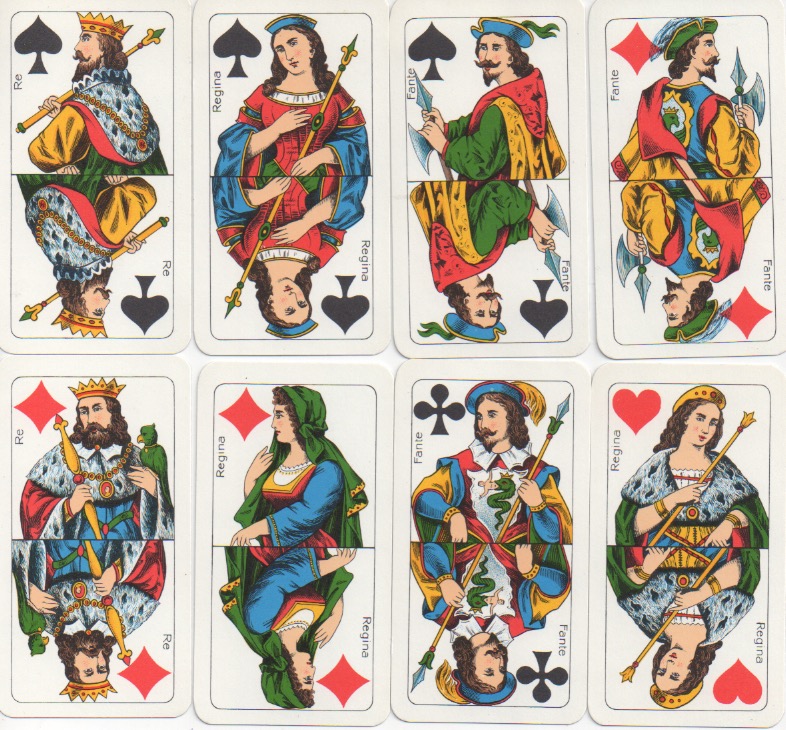
Müller Tresette, Milan pattern
Several non-standard patterns from Turnhout have been copied elsewhere, but the best example of an in-house design that has become a sort of standard one is Dondorf's Rhineland pattern. The courts of each suit face the same way and there are a few hints of the French figures. It was copied in Turnhout with all the figures mixed up or altered in different ways by different makers and even Alf Cooke made a version for the Scandinavian market.

A version for the Portuguese market
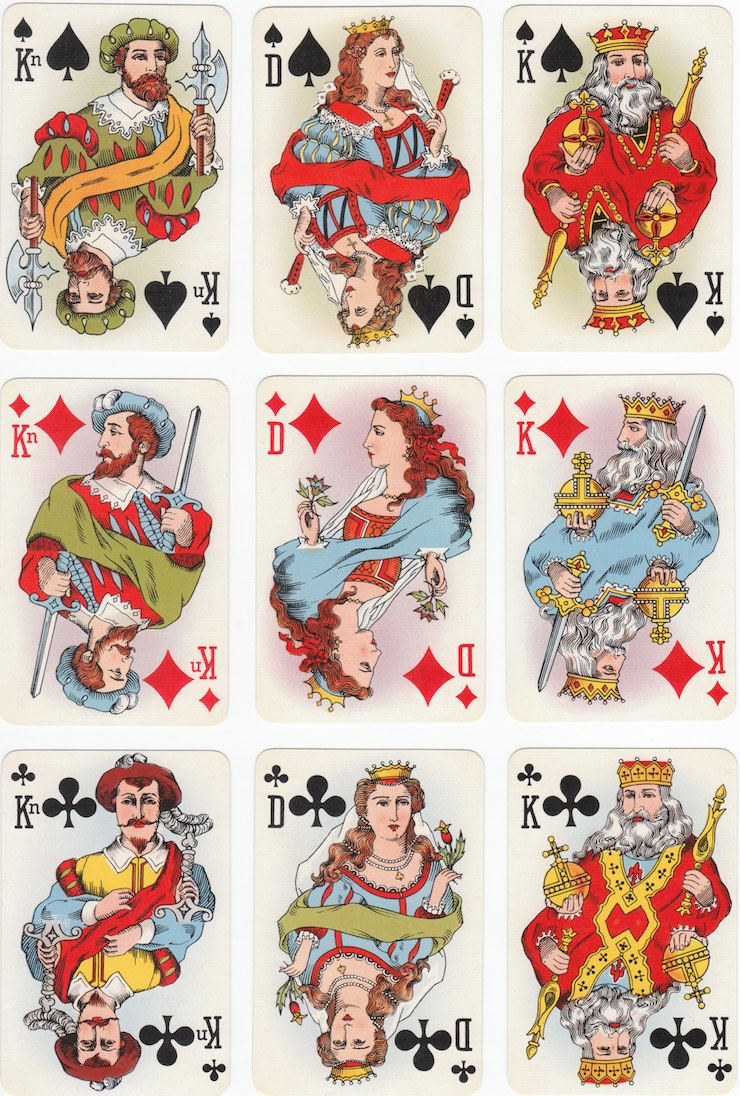
Alf Cooke, Rhineland pattern, c.1960

An anonymous version, possibly by Speelkaartenfabriek Nederland, c.1935
Finally, we can see how the regional French figures have inspired designers to produce their own version of them. Perhaps the first example is from Dondorf from the 1870s, the Birma Karte. These have been described as a version of the English pattern, but they are not. They have been given some characteristics of that style and a couple of the figures are found in the English pattern, but the courts are based on the regional figures we've been discussing here. (For a discussion of which figures are used, see my article in The Playing Card 45/2: 82-84.)

Dondorf Birma
There is also a double-ended version made for Portugal, which has moved some of the figures around.
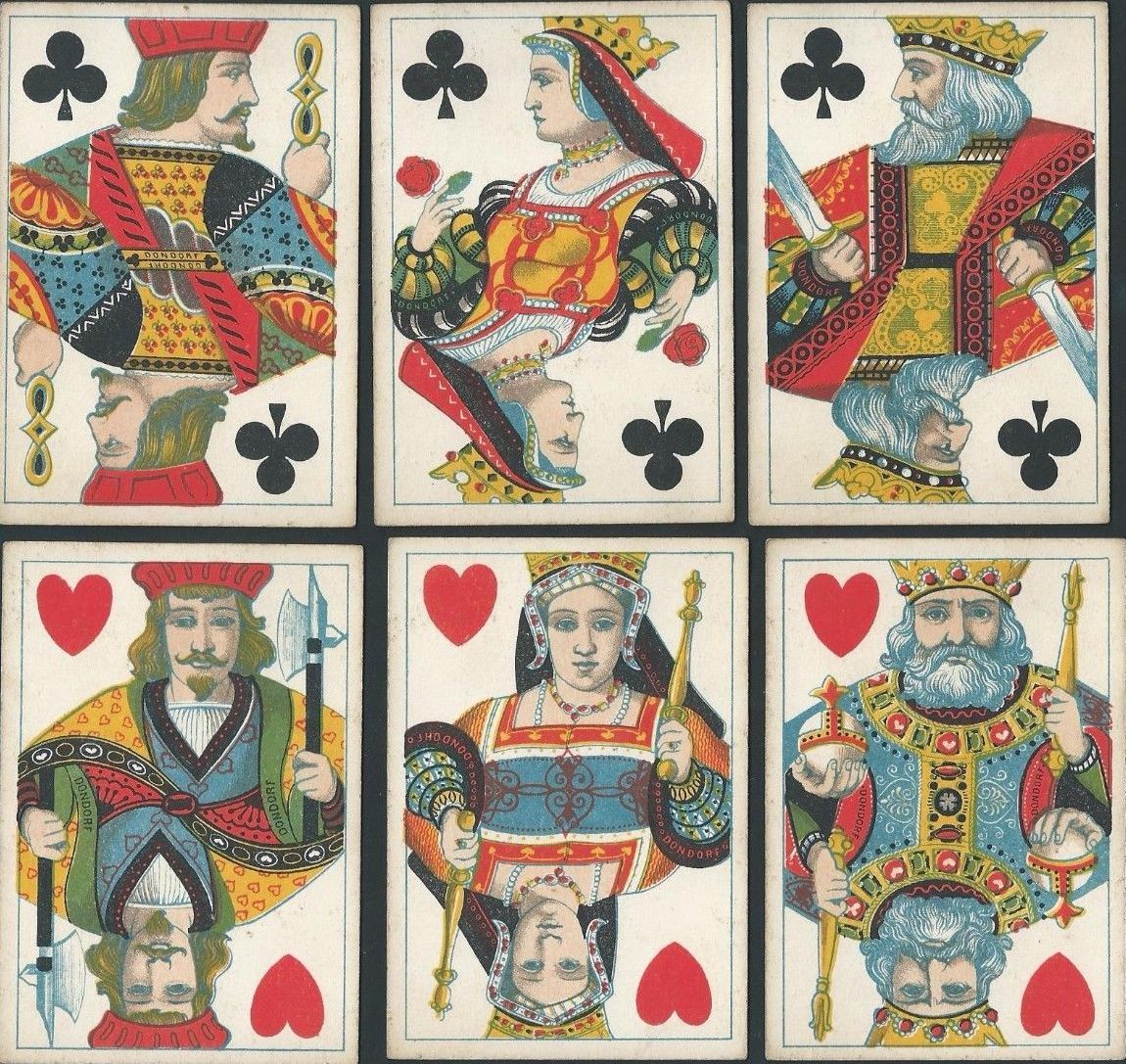
Dondorf for Portugal
The design for Hermès by Cassandre from 1948 also draws on the regional figures for inspiration: the QC is the Paris 1 QC, the KH is K10 fully frontal, and the JH is J1.

Cassandre
Similarly the pack for the Banque National.
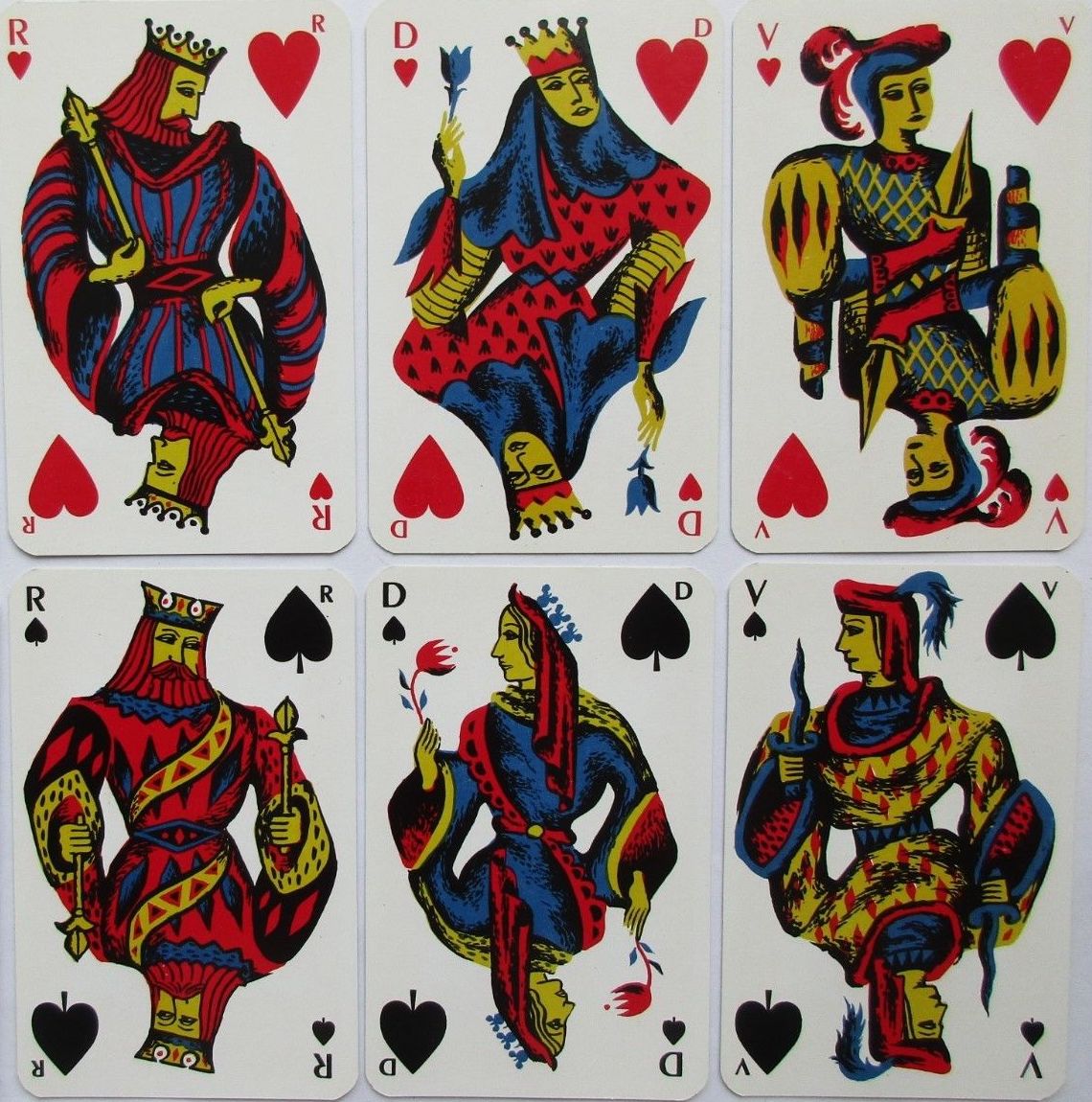
There are also packs by Miro (Ciel de France) and Draeger Frères (Classique), which draw on the French regional figures for their inspiration.

Ciel de France

Classique
The last example is very recent: Rick Davidson's reworkings of the Rouen 2 pattern.

Origins Rouen 1567
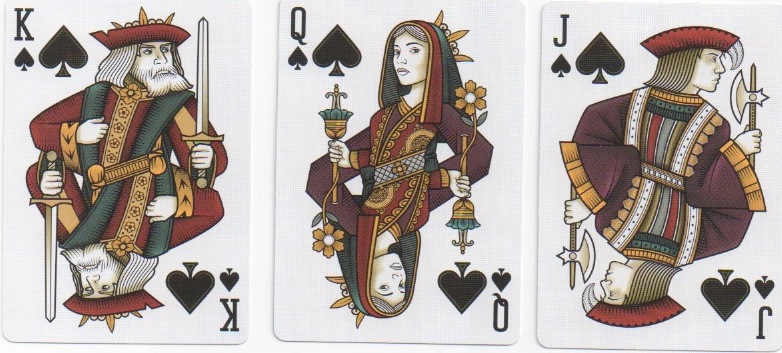
Origins Shadows
By Ken Lodge
United Kingdom • Member since May 14, 2012 • Contact
I'm Ken Lodge and have been collecting playing cards since I was about eighteen months old (1945). I am also a trained academic, so I can observe and analyze reasonably well. I've applied these analytical techniques over a long period of time to the study of playing cards and have managed to assemble a large amount of information about them, especially those of the standard English pattern. About Ken Lodge →

Leave a Reply
Your Name
Just nowRelated Articles

Early German playing cards
Some early examples of popular German playing cards from the XV and XVI centuries.
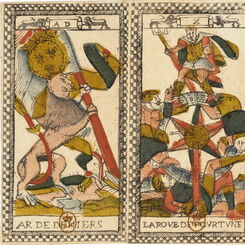
The Parisian Tarot
The “Parisian Tarot”, early 1600s, with imagery and design synthesizing several influences.

73: Fakes, forgeries and Tax Evasion
When there are oficial taxes to pay, people will find a way to avoid paying them - often illegally. ...

A. Camoin & Cie
This deck was inherited from ancestors, it has has a family history surrounding it. Details of the l...
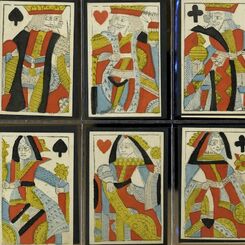
70: Woodblock and stencil : the spade courts
This is a presentation in a more straight forward fashion of the work done by Paul Bostock and me in...

63: The descendants of the French regional patterns: 1
A great many regional patterns were exported from France and subsequently copied elsewhere. Some of ...
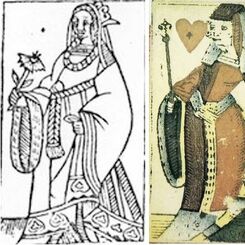
62: French regional patterns: the queens and jacks
Continuing our look at the figures from the regional patterns of France.
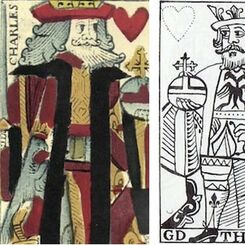
61: French regional patterns: the kings
On page 11 I illustrated several examples of the regional French patterns from Sylvia Mann's collect...

Trentine Pattern
Trentine Pattern

Old Bavarian pattern
Uncut sheets of playing cards of the Old Bavarian pattern by Michael Schatzberger, Passau, c.1780.
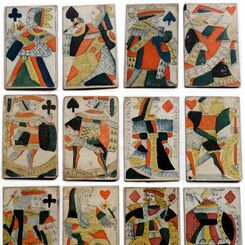
Provence Pattern - Portrait de Provence
The 'Provence' pattern contains figures which go back to the fifteenth century.

25: More Standard European Cards
A further selection of European standard patterns including various redrawings.
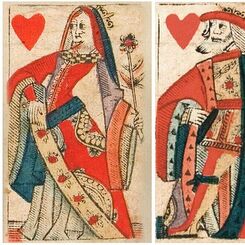
Pierre Marechal
Rouen became an important centre for card-making whose influence extended far afield. Cards from Rou...

Benoist Laius
Spanish playing cards such as these were used in those parts of France where certain games were enjo...

19: 19th Century Breaks with Tradition - Unusual versions of the Standard English Pattern
The centuries-long tradition of English court cards was subject to misinterpretation and in some cas...

Lyon Pattern type iii
This pattern was used in various parts of eastern France but was ultimately replaced by the official...
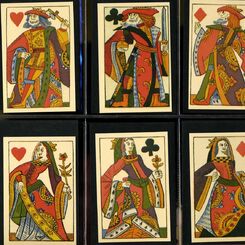
1: Playing Cards and their History: An Introduction and some links to other sites
What was considered the first mention of playing cards in England is in 1463 when Edward I banned th...

Paris Pattern
The Paris pattern was established as such around the middle of the seventeenth century (based, perha...

History of Court Cards
The court cards in English packs of playing cards derive from models produced by Pierre Marechal in ...
Most Popular
Our top articles from the past 60 days


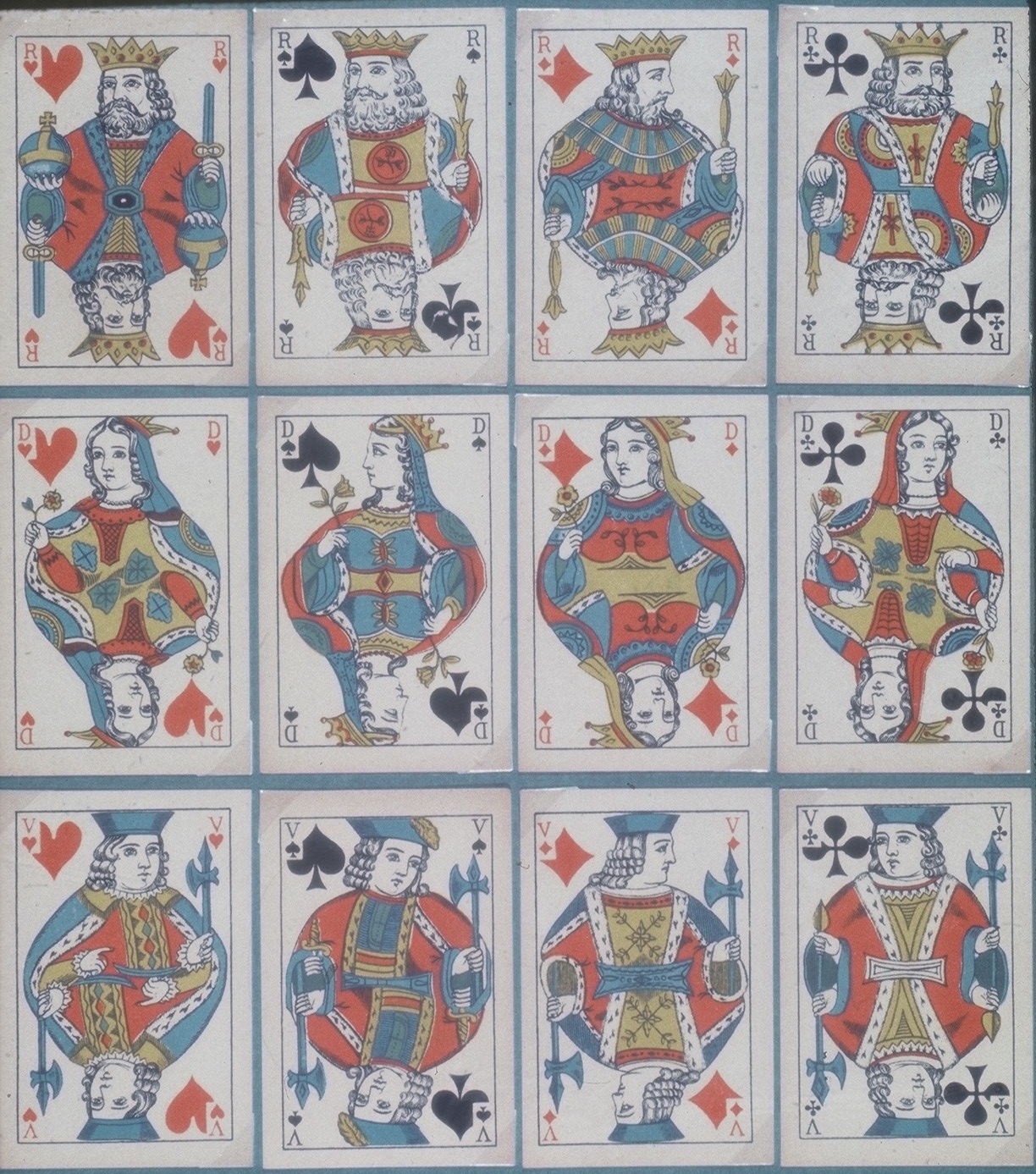
 Your comment here. Your comment here. Your comment here. Your comment here. Your comment here. Your comment here. Your comment here. Your comment here. Your comment here. Your comment here. Your comment here. Your comment here. Your comment here. Your comment here. Your comment here. Your comment here. Your comment here. Your comment here. Your comment here. Your comment here. Your comment here. Your comment here. Your comment here. Your comment here. Your comment here. Your comment here. Your comment here. Your comment here. Your comment here. Your comment here. Your comment here. Your comment here.
Your comment here. Your comment here. Your comment here. Your comment here. Your comment here. Your comment here. Your comment here. Your comment here. Your comment here. Your comment here. Your comment here. Your comment here. Your comment here. Your comment here. Your comment here. Your comment here. Your comment here. Your comment here. Your comment here. Your comment here. Your comment here. Your comment here. Your comment here. Your comment here. Your comment here. Your comment here. Your comment here. Your comment here. Your comment here. Your comment here. Your comment here. Your comment here.





















